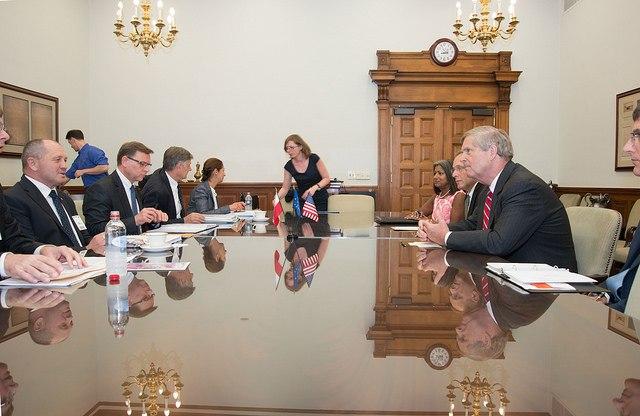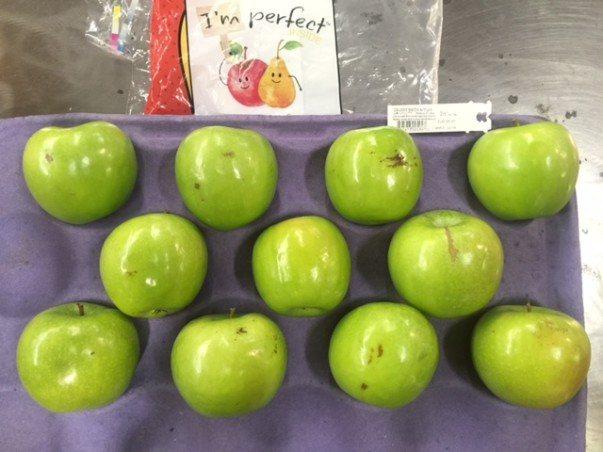Univision Promotes “Access for All” with Community Empowerment Programs


Submitted by Kelly Eisenhardt
By focusing on four areas most critical for success – education, health, prosperity, and civic engagement – Univision is empowering the Hispanic community by providing families life-changing access to information, programs and services.
Jessica Herrera-Flanigan is the Executive Vice President of Government & Corporate Affairs at Univision Communications, Inc. (UCI). In her role, she oversees the Washington, D.C., office of UCI, as well as the Company's community empowerment and corporate social responsibility functions. She leads the Company's efforts to enhance UCI’s presence among policymakers, community partners, legislators, influencers, and stakeholders and develops strategies to address the public policy issues impacting the Company and its audiences. Herrera-Flanigan has long been an influential member of the Hispanic community, having served as president of the Hispanic Bar Association of D.C. and regional vice president for the Hispanic National Bar Association. She is a member of the Council on Foreign Relations and serves on the TV Board of Directors of the National Association of Broadcasters and the Board of the U.S. Center for Safe Sport.
What prompted Univision to release its first CSR report?
Corporate social responsibility has been part of our DNA for more than 60 years, since our first station opened in San Antonio. Our mission has always been to inform, entertain, and empower Hispanic America. "Access for All" and the accompanying video captures how, working with our partners and the community, we bring our mission to life. They showcase how we’ve integrated our values of integrity, collaboration, innovation, diversity, service and excellence into everything we do. The video tells our story and the profound impact we have had on our audiences not through our words but through the powerful visuals and testimonials of those we influence and empower.
Why is connecting deeply with community so important?
Connecting with community is the backbone of our Company and our brand — Univision was created to serve Hispanic America and as the face of the country has changed, so have we. We aim to inform, empower, and bring people together. Inherently, that is what CSR is about. We’ve focused on this throughout our history; even before CSR had a name or was socially important.
Our work is based on one of the most unique and cherished relationships in corporate America – an unparalleled connection to the Hispanic community. Our community trusts us- and we do not take that lightly. With our audiences overwhelmingly and consistently associating us with qualities such as trust, pride, value, loyalty, and responsibility, we are about bringing information, entertainment and access to the communities that need us most. With our CSR report we’ve been able to collect data and illustrate with tangible examples, stories and facts that speak to the depth and scope of Univision’s impact in a format we can share with the world. Our CSR report brings together what we’ve done, our insights, and the status of initiatives we’ve launched across our community base.
How does your company promote diversity, inclusion, and professional development amongst employees?
Univision continues to believe in the importance of serving Hispanic America and the growing multicultural and young, diverse audiences we call the rising American mainstream. We have been committed to supporting diversity across all facets of our business since the beginning. From employee recruitment, to content diversity, to community empowerment, Univision has infused a commitment to diversity into its everyday operations and overarching strategy for business success.
Within our company, a large focus is on inclusion and development. UCI celebrates diversity by supporting Employee Impact Groups (EIG), programs and initiatives that promote inclusion such as the Women’s Leadership Council, a company-wide program representing women at UCI who are breaking the mold, redefining leadership and inspiring others. Also making a difference are initiatives including Orgullo|Pride@UCI – an employee impact group for lesbian, gay, bisexual and transgender employees and their allies. Finally, emerge – UCI’s millennial employee resource group focused on empowering young talent to grow into the next generation of UCI leaders.
In what way is Univision a catalyst for Hispanics in the media industry and in the world?
Today, diverse communities define the fabric of our country, which is why Univision has been committed to meeting the needs of diverse millennial and multicultural audiences championing a more inclusive America.
To make an impact directly in the communities we serve, just this past January we were proud to inaugurate the Univision Media Center at the New Venture Middle School in the Bronx, which enables kids to learn how media works and provides them with the tools and training needed to be involved. In April of this year we continued this initiative and broke ground on new Univision Media Centers in five middle schools across the country including Hernandez Middle School in Austin, TX, Para Los Niños Charter Middle School in Los Angeles, CA, Pulaski International School of Chicago in Chicago, Ill., Ruben Dario Middle School in Miami, Fla., and United for Success Academy in Oakland, Calif.
Also, earlier this year, we partnered with Grupo Televisa, the National Association of Latino Independent Producers, Hispanic Foundation for the Arts, and the National Hispanic Media Coalition in an effort to increase diversity in media and technology. Together we will work to encourage young people seeking careers in media or tech by creating production projects, incubator programs, entrepreneurial opportunities, school programs, and scholarships and fellowships. We have also supported writers' programs and programs to help students learn about the law and policies impacting the industry.
How does your company advocate and contribute to education, health, prosperity, and civic matters?
The Company’s powerful community-based empowerment platform Univision Contigo (Univision with You) focuses on providing resources and information along four pillar areas including education, health, prosperity, and civic engagement.
Our education program is a multi-year, multi-media initiative aimed to increase Hispanic educational attainment from early childhood, through high school and college readiness. The initiative raises awareness about the importance of postsecondary education and provides concrete tools and resources to help students achieve their academic and professional goals while providing resources and support for parents to be involved in their child’s academic and professional journey along the way. Univision’s education initiative is the nation’s longest-running education campaign on the air in any language, spanning across television, radio, digital and community events. In 2015, more than 40,000 attendees participated in Univision education fairs nationwide.
Our health campaign includes a variety of programs, including Camino a la Salud or “Road to Health” tour that serves more than twelve markets in the U.S. In 2015, our health fairs had more than 30,000 attendees with over 10,000 health screenings completed. Last year, we also raised $15.7 million for Teletón USA as well as $3 million for St. Jude’s Children’s Research Hospital. Our Health initiative's cornerstone is "Reto28," a free digital tool with a 28-day nutritional diet plan and fitness challenge. More than 377,000 people have signed up for Reto28. Since its introduction in 2015, challenge participants have lost 238,840 pounds.
Within the communities we serve, there are often obstacles toward attaining financial prosperity. There can be a lack of awareness with regard to financial management skills. Our programs, including small business boot camps and prosperity fairs, teach people how to save money and qualify for loans, among other things. In 2015, more than 60,000 people attended prosperity fairs and town halls across the country.
Through our nonpartisan Civic Participation initiatives, Univision Contigo is taking strides to ensure Hispanic voters have access to the information they need to be heard in the electoral process. In February 2016, Univision unveiled the groundbreaking “Vote For Your America” campaign to engage multicultural, millennial and Hispanic voters. The effort includes the first-ever “Vote For Your America” Digital Election Guide, a Bilingual Text Message Tool, on-air and multiplatform messaging, and hundreds of local events leveraging 126 local TV and radio stations. Univision Contigo is also proactively helping eligible Latinos become citizens through the “Hazte Ciudadano” campaign that, in turn, allows them to play an integral role in the U.S. democracy.
Anyone wishing to review the voting guides can go online to www.YourAmerica.com and check out the toolkit. The whole process is documented. It tells citizens how to register, how to apply for absentee ballots, all in a digital guide. Additionally, we’ve launched a series of PSAs to encourage people to get out and vote. We’re very excited about this effort to energize and empower young, Hispanic and multicultural communities.
What can people focus on in their own companies to broaden diversity and inclusion in their own company and how can they learn more about Univision’s work?
It’s most important to build relationships within the communities you want to serve. Building trust and engaging the communities to work with you is critical. Through our Access for All report and video, we hope that people get a glimpse at the heart of what Univision truly stands for and the role we play with our communities across the country.
(Photo: Jessica Herrera-Flanigan)
US-EU Transatlantic Trade Offers Biofuel Incentives But Puts Climate at Risk, Say Critics


So much for the G20 recent pledge to stop climate change. According to an article published last week by the Guardian, EU transatlantic trade negotiators are already eyeing new loopholes that may allow member states to slip out of their obligations to reduce fossil fuel use within the next decade.
The proposed Transatlantic Trade and Investment Partnership (TTIP), which is designed to increase investment deals in the EU and the US has always had its vociferous critics, but the latest draft has environmentalists on alert. According to the Belgium-based advocacy group, Friends of the Earth Europe (FOEE), the new proposal, which arrived in form of a leaked draft, will work against energy efficiency by encouraging companies to "self-regulate" rather than comply with oversight requirements that are designed to improve energy efficiency, not just meet the minimum requirements.
"There is a body of evidence that suggests that self-regulation is not effective in order to achieve public-interest objectives," says FOEE.
A spokesperson for the European Environmental Bureau agreed with the assessment.
“Voluntary agreements have a place, but are generally ‘business as usual’ and no substitute for the real thing. If they became the norm, it would seriously harm our fight against climate change,” Jack Hunter told the Guardian.
But it is the impact that the TTIP could have on natural gas production that has the FOEE and other environmental organizations most concerned.
The TTIP analysts suggest, could open up the trade route for U.S. natural gas. And doing so, says the FOEE, would mean less focus on ramping back fossil-fuel energy production and "more fracking in the U.S."
Paolo Natali, Christian Egenhofer and Gergely Molnar, authors of "Energising the TTIP: Political Economy of the Trade Policy Rationale" point out in order for the U.S. to export natural gas, it must, by law, have a trade agreement in place. But that's assuming, say the authors, that Europe would actually be interested in U.S. natural gas -- something they suggest may still be open to speculation. "LNG exports to Europe will depend on regional pricing, which however is in flux right now. Europe would have to want LNG for this pattern to be put in place."
What is more likely to garner interest, however, say the authors, is the U.S.' resilient biofuels industry, which remains one of the largest in the world. According to the U.S. Energy Information Administration, the nation's biodiesel production stood at 119 million gallons in April 2016, slightly down from the previous month. With almost 100 biodiessel plants in production, the U.S. offers a viable market to a hungry region.
But the FOEE isn't the only organization keeping an wary eye on the TTIP's fine print. Other critics find the availability of "get-out" clauses that don't demand absolute adherence to climate commitments worrisome. Clauses that allow participants to consider the risk of trade distortions as countries adjust to new energy policies also may allow them an "out" to sticking to cleaner energy.
The vagueness of wording, says Cecile Toubeau, who serves on the European Commission's advisory panel, points out that the simple answer is ensuring there is a chapter that addresses energy policies and climate mandates in "a legally binding chapter. Without a concrete timeframe to end fossil fuel subsidies," notes Toubeau, "it will be impossible to stop our oil addiction and therefore uphold the Paris deal.”
While Natali, Egenhofer and Molar's research was released as much as year prior to the recent TTIP leak, their analysis offers one more insight into whether the global climate is really at risk from the transatlantic trade agreement: Europe's own fuel quality directive. Under EU law, potential fuel quality imports are rated by their carbon intensity. Fuels coming from Canada's tar sands or the U.S. crude sources would face opposition to entry. That's not to say those barriers couldn't be relaxed, note the writers. But EU guidelines would probably have to be rewritten -- or removed to allow for U.S. fossil fuel imports. The EU Fuel Quality Directive, while practical in its design, the authors point out, has still to be converted to enforceable standards.
Images: 1) Flickr/USDA; 2) Flickr/Global Justice Now
Tesla Announces Part 2 of Its Master Plan, With Part 1 Still Unfulfilled


You might doubt the Tesla-SolarCity merger, but you cannot dispute the ambition and vision of Elon Musk. His drive to disrupt the financial sector proved successful. And with the money Musk made from PayPal, he set out to transform the transportation and energy sectors. A decade after outlining his first master plan for Tesla, Musk released a sequel that aroused a wide range of reactions from the media.
Dystopian yet optimistic, Musk builds on last month’s announcement that Tesla and SolarCity will become one. “We must at some point achieve a sustainable energy economy,” Musk wrote, “or we will run out of fossil fuels to burn and civilization will collapse.” To that end, Musk’s vision is part defense of the Tesla-SolarCity alliance, part fist-shaking at his critics. And, of course, it's unapologetically bombastic and futuristic. The main points of the plan include:
- Integration of clean energy generation and battery storage
- The scaling of electric vehicles beyond passenger cars to heavy-duty vehicles and buses for public transportation
- Autonomous cars, which will further enable ridesharing and allow Tesla to take on services such as Uber
Reactions, of course, were all over the map. “Tesla stock falls,” screamed the Los Angeles Times. “Execution still an open question,” declared CNBC. “An even more grandiose vision of the world,” mocked Fox Business. Bloomberg yawned, saying the announcement “falls flat.” Other commentators expressed surprise, from the new focus on trucks to Musk’s description of a future that goes far beyond cars and transportation.
But many skeptics say the issue with Musk’s second act is that the first one has not yet reached fruition. Yes, the first models that Tesla rolled out to the market disrupted the automobile industry, as the future of transport also came with a stellar design that wins plenty of attention at any automobile show. But Tesla continues to lose money. Furthermore, while the number of orders for the mid-range Tesla Model 3 are astronomical, the recent decline in deliveries of its Model S raised red flags. And as far as becoming a huge clean energy provider, that vision from 2006 remains to be seen. The SolarCity deal could make that goal a reality, but the merger is still not set in stone.
Musk has a history of making bold predictions -- which helped him groom a devoted following, while angering skeptics of both his companies and the emerging clean technology sector at large. And despite all the bold announcements and naysaying, there is much to admire about what Musk is trying to do. His “gigafactories” in Buffalo, New York, and Reno, Nevada, have the potential to help transform those regions’ economies. A focus on electric buses and trucking can help shift those vehicles away from fossil fuels and help cities tackle their climate change goals.
Indeed, the dream of having a Tesla car that can be summoned at any moment to take you to work, or make money for you by carting around passengers when you are on vacation, is an awesome scenario. But it is not unreasonable for Tesla’s investors to demand that the company’s original master plan become a reality. Tesla’s fans, its investors and the market deserve to see that plan fulfilled before a new Tesla-SolarCity entity embark on a new, expensive plan that looks great on paper but risks the company’s long-term prospects.
Image credit: Joseph Thornton/Flickr
Pokémon Go and the Power of Social Influence


Pokémon Go has quickly and unexpectedly become a wildly successful global phenomenon. In the first week, the app had over 10 million downloads. It now exceeds Twitter in daily average users and has a higher average user time than Facebook, Instagram, Snapchat and WhatsApp.
Yes, a game where you wander around the neighborhood catching virtual monsters is probably the most successful app of all time. And even if Pokémon Go is just a flash in the pan, it’s interesting to see how it changed the game when it comes to leveraging the power of social influence.
It’s nothing new
At first glance, there’s nothing inherently new about Pokémon Go. In fact, the game has been around for ages. The franchise has been popular since the mid 1990s, spanning both eastern and western cultures. What started as a humble pair of video games for the original Game Boy quickly became the second most successful and lucrative video game-based media franchise in the world, behind only Nintendo's Mario.
It’s no surprise that a digital revamp of the nostalgic game millennials grew up playing on their Game Boys would be so huge. We’re already obsessed with our phones as it is. And now we can use that obsession for a greater good -- capturing playful, colorful monsters running rampant through our streets and towns.
It’s interactive and engaging
“What makes Pokémon Go so intriguing is the fact that it encourages people to be more socially and physically active” said Jeremy Worker, a marketing and publicity specialist for social influencers and purpose-driven brands. “It combines the mobility of the Game Boy, the physical fun/exercise of the Wii, and the exciting new experience of location-based augmented reality.”
“This gives a reason for just about anyone to be interested. Whether it’s an excuse for exercise and exploration, social engagement, or simply to geek out on nostalgia at such a graceless period in our history. Folks are moving outside in hoards and engaging with one another," Worker said.
It leverages the power of social influence
Social influence played a critical role in making Pokémon Go happen. “Social influence is critical when it comes to engaging new people, especially those outside of your target audience,” Worker told 3p. “Pokémon was huge long before social media, but the culture was much more niche. It was geared more toward Anime lovers and cartoon-aged kids,” he explained.
Yet somehow in our technology-obsessed and overly-connected world, a niche brand managed to break through the noise and come out on top. Pokémon Go has become a social epidemic. However, its newfound success is built upon some fundamental ideas, many of which John Berger outlines in his book, "Contagious: Why Things Catch On."
It’s all about word of mouth
Word of mouth is the primary factor behind 20 to 50 percent of all purchasing decisions. It's way more effective than more traditional advertising techniques for two key reasons. First, it’s more persuasive. We are more likely to trust the opinions of our family and friends than an advertisement.
Think about the last new restaurant you tried or that app you downloaded because your friend suggested it. We take the word and opinions of those around us as bond. It’s in our nature. We are constantly selling thoughts, ideas and products in our daily conversations.
Secondly, word of mouth is more targeted. It’s naturally directed toward an interested audience. We don’t necessarily share an interesting news story or recommendation to everyone we know (aside from Facebook). We tend to select particular people who we think would find that given piece of information most relevant.
This idea alone is what made Pokémon Go blow up long before social media got ahold of it. And although word of mouth is the primary factor behind most purchasing decisions, only 7 percent of it happens online. If you downloaded the game within the first few days of its release, chances are you were prompted to do so by a friend.
It cashes in on social currency
In general, people want to be cool. They want to be in the know. Knowing and talking about cool things makes you seem cool. People share things that make them look good to others. Just as people use money to buy products and services, they use 'social currency' to achieve desired positive impressions among their families, friends and coworkers.
The basic idea is to give people a way to make themselves look good while promoting your products or ideas. One way this can be achieved is by leveraging game mechanics. Users can post screenshots of the rare Pokémon they just caught on social media, or even play with friends to tally scores. This comes naturally for a game, of course, but true game mechanics can be applied to almost any brand, business or cause.
It’s inclusive
“I’ve personally been surprised to witness swarms of unexpected gamers -- from seniors to parents with their children, to squads of awkward pubescent boys and girls -- all out and about in the blazing summer heat,” Worker told us. “I’ve never seen a phenomenon like this before.”
The inclusive nature of this game enabled what was once a niche community to become more accessible and less mysterious. “You no longer have to learn how to play from someone else within that community,” he explained.
“You can do your own research, download the app and become a Poké Master without the awkward learning curve conversations that come along with entering into any exclusive groups. This has created exponentially more exposure and has led to a greater, more significant growth in terms of the sheer amount of active interest and engagement.”
It’s remarkable
Pokémon Go is remarkable in the sense that location-based augmented reality is still a relatively new concept. The idea that a Pokémon can appear on a sidewalk or even in our own backyard is mind-blowing for some. This is not only the future of gaming, but also the future of how we interact with our world.
Although the Pokémon craze may die down a bit in the coming days, weeks or months, it still remains a shining example of how social influence can inspire a social epidemic. The question here is: How might this new technology be used as a tool for social innovation?
“Companies are investing heavily in these physically and virtually interactive realities that all seem to cultivate this sort of sub-currency," Worker said. “Maybe in the future, companies can build in incentives for good deeds in exchange for virtual currency, like picking up trash, recycling or getting involved with community activities. The possibilities are endless.”
Image credits: Brandon Simmoneau via Mauna Nada (used with permission)
Anheuser-Busch’s 'Barley Grower Days' is Top-Notch Engagement


Barley, one of the world's oldest cultivated crops, blankets the rolling landscape of eastern Idaho like softly waving fur. A large portion of it is destined to be processed into malt, the key ingredient in beer, and several large malting facilities are located nearby. Among them is a 220-foot high Anheuser-Busch facility in Idaho Falls which processes millions of bushels of barley a year from close to 400 independent growers into malt destined to become Budweiser and Bud Light at AB's many distant breweries.
The key stakeholders in AB's barley supply chain are the growers, and maintaining good relations is a full-time pursuit. It also includes a shared incentive to look at crop sustainability -- particularly as it pertains to resource consumption and productivity. This relationship shines most obviously at AB's annual "Grower Days" celebration in Idaho Falls which attracts hundreds of growers to learn about new efficiency techniques, swap best practices, and in general give growers a chance to interact with each other and have direct dialogue with their largest customer.
I was invited to drop in to the festivities last week and learn a thing or two about barley and the efforts AB is making to make the crop more sustainable. But what most impressed me was the level of interaction the company put forth with its customers -- the growers. It wasn't just a show of appreciation; it was fairly rigorous interactive session where AB discussed its research into new barley strains and listened to grower feedback.
It began in the test fields that surrounded the malting facility -- carefully laid-out rectangles featuring different crop strains, different watering conditions and different levels of inputs like fertilizer. A crowd of at least 100 people was gathered around impassioned speakers, carefully describing the nuances of each test plot. Some strains, I learned, were better suited for dry-land growing (without using any irrigation at all) and others fared better with a steadier supply of water -- not always a possibility in arid eastern Idaho. Others were known to be more resistant to certain insects or to be hardier in the event of heavy winds.
The data that AB collects about crop performance isn't only coming from their own test plots. The company has also installed portable weather stations called "AgriMet Stations" at farms around the region that gather detailed info on a host of different metrics: evapotranspiration, wind speed, temperature, humidity, other weather-related data and so on. The overall goal, in all cases was to find the perfect set of varietals for the multitude of microclimates and other differences among farms.
The result of this and other efforts is the planting of specially-adapted winter barley, which uses an impressive 25 percent less water than regular varieties. That's more than 1.5 billion liters a year that doesn't need to be diverted or pumped out of the ground for irrigation.
None of these accomplishments would be possible, however, if it were not for cross-farm collaboration and the willingness of farmers to share data with each other and with the company. Additionally, the company's willingness to fund the Agrimet Stations and the research into different barley strains and growing conditions creates a perfect platform for a win-win scenario.
It's no wonder so many farmers turned up to interact with the company at grower days. The combination of fun and appreciation with hard-nosed research and education made for impressive stakeholder engagement and, hopefully, continued efficiency for the sake of sustainability.
Image credits: Nick Aster
Note: Travel expenses to Idaho Falls were covered by Anheuser-Busch
Video: Learn more about AB-inbev's Smart Barley Program
https://www.youtube.com/watch?v=vPyTRVUETqw
Missing the Target with Conservation Finance


By Sean Penrith
“Are we doing enough?” This was the question Patrick Westerlund of the Wells Foundation asked a packed room in a session titled “Missing the Target” at the 2016 Mission Investors Exchange (MIE) conference in Baltimore. He added that with just the money represented in the room, we could change the world. Based on Patrick’s comments, clearly we are not doing enough.
I recently met with a very large and respected carbon project developer who explained he was in growth mode, and was scouting for expansion capital to keep his pipeline of projects moving. His challenge was finding financiers who were more, as he put it, “planet focused,” which is exactly what led him to us. With all the available capital seeking impact and returns, there is a sharp disconnect in channeling it to where it is most needed; initiatives reducing carbon emissions.
At the MIE conference, I heard a lot of well-intentioned heads of foundations and impact firms proudly describe how they had crafted bespoke investment deals carefully sourced with tons of due diligence, structuring, and contracting. Their point understandably, was that they were putting their philanthropic capital to work in a very diligent and prudent manner to ensure that projects delivered real results. A perfect sentiment; but one that is too limiting to achieve the scale of conservation finance we need to address the alarming rate of our warming planet.
Jenny Yip of the Gates Foundation nailed it when she recommended that the impact community shouldn’t, “trickle out money,” in reality they should, “bet big and commit!” This was right in line with Jesse Fink’s comment at the afternoon plenary at MIE, stating he hoped to see the ease of investing in muni bonds replicated in the sphere of impact investing. Fink expounds on this further in his piece, “Hope and the New Energy Economy,“ where he urges mission-based capital to be the “bridge to accelerate the transition to a low-carbon economy.”
Julia Stasch, who heads the MacArthur Foundation, told the MIE audience that the purpose of philanthropic capital was to “send a signal of confidence to the market.” I agree! The urgent need to transition to a low carbon economy offers a tremendous opportunity to create new and powerful financing mechanisms that support this shift, and offer a strong role for philanthropy, educational institutions, endowments, and pension funds to drive capital to high climate impact areas while still offering an economic return.
The required funding needed to support the low-carbon transition is estimated to be $4.8 trillion according to the 2015 report, “Banks and Climate Change Impact.” Lauren Compere, managing director at Boston Common Asset Management, summed it up nicely; “Paris has created a fast track to a multi-trillion dollar opportunity for the world's largest banks, but they will need to up their game if they want to claim the reward.” Opportunity awaits!
The Packard Foundation is one entity that is sending this vital market signal. As anchor investors in The Climate Trust’s pilot carbon investment fund, by way of a Program Related Investment, they are serving to support and spur the value proposition that investing in greenhouse gas reducing projects does offer triple bottom line results and market-based economic returns.
The MIE professes to deliver a “call to action for the impact investing community to take advantage of the latest investment opportunities and innovations that can help tackle society's most intractable problems.” My hope is that the next time we gather, the thinking and approaches of this pioneering group evolve to offer that vital bridge to low carbon financing.
We need it!
Image credit: Flickr/Bureau of Land Management Oregon and Washington
Sean Penrith is the Executive Director for The Climate Trust.
The Olympics and Other Mega Events: A Boon or a Burden for Local Communities?


By Dr. Dogan Gursoy
The World Cup and Olympic Games are time-honored traditions. Every few years, people unite to watch these enormous sporting events and support their country. Bidding for the honor of hosting these mega events, countries hope to attract tourists from around the world, create new jobs and gain international recognition from the media coverage surrounding these events. However, this honor comes with the responsibility to create effective spaces for the thousands of athletes and tourists alike. Most recently, Brazil hosted the World Cup, and is quickly preparing for the Summer Olympics in Rio this August.
Although these mega-events bring benefits and costs to the host country, detrimental impacts can offset the perks. Price inflation, tax increases, mismanagement of funds, traffic congestion, increased crime and cultural conflicts are just a few potential consequences. These, among other issues, can lead to opposition from local residents. Additionally, these events may have negative environmental impacts, including increased pollution and the destruction or deterioration of natural, cultural or historical resources. Countries can lessen these effects by implementing a more democratic process to build trust among stakeholders and gain support from residents.
Brazil has been a prime example of how a mega event can go wrong. In 2014, Brazil spent huge sums of money (~ $11.3 billion) on World Cup-related infrastructure improvements. Many Brazilians felt that the large funds spent benefited elites while further marginalizing disadvantaged groups. Fed up with poor public services and corrupt politicians, massive protests broke out over the large sums spent building stadiums and event infrastructure. Protesters argued that the money would have been better spent on hospitals, schools and public transportation.
A democratic process
Unfortunately, due to the intense competition to host these events, leaders and organizers often ignore the negative impacts and glorify the expected benefits. While mega events require considerable investment of human, financial and physical resources from host communities, they have traditionally involved a political planning approach. This approach normally allows little to no input from local residents. Implementing a more democratic planning process can have significant impact on residents’ support for the event.
Implementation of more democratic planning approaches, for example Toronto’s bid for the 1996 Summer Olympic Games, suggests community involvement and support can transform a mega-event into an urban festival that provides a significantly more positive experience for hosts and guests.
Building trust and support
While successfully hosting a mega-event requires all stakeholders to trust the government and the organizing committee, lack of trust within the host community can turn the planning process into a highly charged political and social exercise. Community opposition can lead to demonstrations, delays and legal action, as we have seen in Brazil.
Politicians make most decisions regarding the hosting of a mega-event, making political trust critical in legitimatizing event decisions. Therefore, trust is important in gaining residents’ acceptance and support. High levels of trust can make residents feel the strategies in place will minimize negative consequences while maximizing positive outcomes.
Support and involvement of local residents is necessary for three important reasons:
- Tax increases to build infrastructure and facilities need support from residents in the voting booth and on the streets.
- A friendly and hospitable local population is critical to creating a great experience for guests.
- Local support and involvement are likely to increase the longevity of positive impacts on the local community.
The greater the concern for the community, the more support a mega-event is likely to attain. It is crucial to take community members’ priorities into account during the planning process because they will feel these effects for years to come.
Image credit: Flickr/Rodrigo Soldon 2
Dr. Dogan Gursoy is the Taco Bell Distinguished Professor in Hospitality Business Management at Washington State University's Carson College of Business School of Hospitality Business Management and the editor of the Journal of Hospitality Marketing & Management
3p Weekend: Why The Republican Platform Should Concern Environmentalists


With a busy week behind you and the weekend within reach, there’s no shame in taking things a bit easy on Friday afternoon. With this in mind, every Friday TriplePundit will give you a fun, easy read on a topic you care about. So, take a break from those endless email threads and spend five minutes catching up on the latest trends in sustainability and business.
The GOP officially released its 2016 platform at the Republican National Convention on Monday (PDF). A broad array of stakeholder groups, ranging from immigration-reform advocates to LGBTQ people and their allies, were predictably concerned by its contents.
Some are paying the platform less mind, saying Republican nominee Donald Trump is unlikely to follow it anyway. “No reasonable Republican thinks the platform has any real heft, and hardly expects that it'll be something that Trump will care enough about to abide," a GOP strategist, who asked for anonymity to speak candidly, told Politico last month.
Trump's VP pick, Indiana Gov. Mike Pence, strikes us as a bit more of a stickler. And even if the platform is forgotten after Election Day (as many are), the fact remains that it was devised by party higher-ups as a wish list for America. So, we wouldn't be so quick to count out the 66-page document.
Social progressives have plenty of qualms with the text and its purported plans to "defend traditional marriage," replace sex-ed in public schools with abstinence-only lessons, and seek "special scrutiny" for Muslim immigrants. But for the purposes of this story (and your finite coffee break), we'll focus solely on the environment this afternoon.
And believe us, there's plenty of material.
See ya, EPA!
Under the ironic heading "environmental progress," the platform's authors proudly proclaim, "Conservation is inherent in conservatism" (page 20, for those following along*). They then go on to advocate for the end of the Environmental Protection Agency as we know it.
"Our modern approach to environmentalism ... starts with dramatic change in official Washington," the platform reads (page 21). Namely this involves turning the EPA into "an independent bipartisan commission." This would effectively remove the federal government’s ability to study the effects of pollution and establish safe standards.
The platform also calls to "forbid the EPA" from regulating carbon dioxide, "something never envisioned when Congress passed the Clean Air Act." Because apparently the gains in climate science over the past 46 years should be tossed aside in favor of this initial "vision."
Ben Adler, who covers environmental policy and politics for Grist, summed up the plan nicely: "In a particularly Orwellian touch, the Republicans promise that a kneecapped EPA would adhere to 'structural safeguards against politicized science.' That actually means safeguards against scientific findings they don’t like. In other words, they would politicize the science."
Keep it in the ground? Pfft... forget that
Environmental advocates insist the majority of fossil fuel resources must remain untapped if we are to limit global warming to 1.5 degrees Celsius. The Republican Party acknowledged this mission in its platform, although not in a way these advocates would like.
"The Democratic Party’s energy policy can be summed up in a slogan currently popular among its activists: 'keep it in the ground.' Keeping energy in the earth will keep jobs out of reach of those who need them most," reads the 2016 GOP platform (page 19).
And the party doubled down on the good ol' sustainability-as-a-job-killer narrative. They called for opening public lands and the outer continental shelf to oil, gas and coal exploration, "even if those resources will not be immediately developed." They then pledged to "do away with [the Clean Power Plan] altogether."
Keystone XL? Bring it on!
As part of its purported "all-of-the-above" energy strategy, the Republican Party vows to move forward with the Keystone XL pipeline. They called the rejection of the pipeline "a symbol of everything wrong with the current administration’s ideological approach" (page 20).
"After years of delay, the president killed it to satisfy environmental extremists. We intend to finish that pipeline and others as part of our commitment to North American energy security." (Yes, "environmental extremists." We are 100 percent serious. Page 20. Look it up.)
Carbon tax? Hell no!
The majority of the sustainability community insists a shift to renewables won't happen without a tax on carbon. More than half (51 percent) of self-proclaimed Trump voters support a carbon tax on businesses. And as of last year, more than 1,000 companies worldwide — including 18 energy firms — had already set an internal price on carbon.
But never mind them, say the authors of the 2016 GOP platform. "We oppose any carbon tax," they wrote succinctly (page 20). "It would increase energy prices across the board, hitting hardest at the families who are already struggling to pay their bills in the Democrats’ no-growth economy."
Instead, the GOP suggests we turn to carbon capture and storage (CCS, sometimes called carbon sequestration) to limit emissions. Proponents claim the technology can capture up to 90 percent of the CO2 emissions generated by fossil fuel power plants. But environmental advocates often call it a crutch aimed to keep these plants open, even as cleaner energy sources become more readily available.
Not enough buyers for all that natural gas? We'll fix that
With continued natural gas drilling and exploration, brought on by the increased use of less proven extraction methods such as hydraulic fracturing (fracking), U.S. companies now have a natural gas surplus.
Does this mean we should slow drilling and heed the calls of communities who don't want fracking in their backyards? Nah. Let's just export that gas to help neighboring countries increase their own CO2 footprints.
"We must expedite the energy export terminals currently blocked by the administration," the platform's authors wrote (page 20). They also oppose the Bureau of Land Management's rule that seeks to limit fracking, saying "we respect the states’ proven ability to regulate the use of hydraulic fracturing, methane emissions and horizontal drilling."
How about some agricultural runoff with that tap water?
"Like the rest of the economy, agriculture has suffered through eight years of the Democrats’ regulatory juggernaut, particularly from the Environmental Protection Agency," reads the platform (page 17). It goes on to call the EPA’s Waters of the United States (WOTUS) rule, issued jointly with the U.S. Army Corps of Engineers, "a travesty."
But invalidating WOTUS "will not be sufficient," the authors went on. They call for taking all agricultural regulation out of the hands of the EPA and the federal government, and turning it over to the states. It also seeks to privatize 200 million acres of forest land now under the control of the U.S. Forest Service.
You can't sit with us, UNFCCC!
The Obama administration requested $13 million in funding for the U.N. Framework Convention on Climate Change (UNFCCC) in fiscal year 2017. A group of Republicans took aim at the administration's plans in April. And the GOP continued with this trend in its 2016 platform.
"We demand an immediate halt to U.S. funding for the U.N.’s Framework Convention on Climate Change (UNFCCC)," the platform reads (page 22). The authors say the UNFCC is "a political mechanism, not an unbiased scientific institution" -- adding that its "unreliability is reflected in its intolerance toward scientists and others who dissent from its orthodoxy" (aka climate deniers).
In further attempt to get all of this politics out of the climate change conversation, the platform's authors "reject the agendas of both the Kyoto Protocol and the Paris Agreement."
The icing on the cake
Really, the entire "environmental progress" section should be read in full. (Here's that PDF again: pages 20-22) But these gems further illustrate how the GOP at-large seems to view the environmental movement:
- "The environment is too important to be left to radical environmentalists. They are using yesterday’s tools to control a future they do not comprehend."
- "We assert that private ownership has been the best guarantee of conscientious stewardship, while some of the worst instances of degradation have occurred under government control."
- "The environmental establishment has become a self-serving elite, stuck in the mindset of the 1970s, subordinating the public’s consensus to the goals of the Democratic Party. Their approach is based on shoddy science, scare tactics, and centralized command-and-control regulation."
Jeez, guys. Tell us how you really feel.
The bottom line
This is not to say that all Republicans refute the existence of climate change or put profit above environmental conservation. In fact, 62 percent of self-proclaimed Trump voters support the regulation of carbon dioxide as a pollutant, according a survey conducted in May by the Yale Program on Climate Change Communication. Even a mayor from Mike Pence's home state represented a small but present voice for climate action at the RNC.
Indeed we should lift up these stories and share them loudly. Climate action and environmental conservation should not be partisan issues.
But the language of the platform is unsettling to say the least. And if nothing else, it should inspire voters to look beyond Trump. A total of 469 seats in the U.S. Congress are up for election this year. It is equally important to look into the policies of your Congressional representatives. If they side with this environmentally destructive platform, it may be time to look elsewhere.
*Please note that all page numbers refer to pagination directly within the platform text (which excludes introductory pages). Pagination on your PDF viewer may be different.
Image credits: 1) Flickr/Wladimir Labeikovsky; 2) Flickr/Thomas
Walmart’s Embrace of ‘Ugly' Fruits and Vegetables Fights Food Waste and Hunger


Earlier this week, Walmart announced in a blog post that it would start selling “beautifully imperfect” apples at some of its stores. The world’s largest retailer is the latest supermarket chain to start a rollout of “ugly fruits and vegetables” as more companies in the food industry realize they have to take a leading opportunity to reduce food waste and confront hunger in America.
Depending on the source cited, anywhere from 30 to 40 percent of the food in the U.S. and other industrialized countries is wasted. There are several underlying reasons: poorly designed packaging, confusion over “use by” and “sell buy” dates, inefficient distribution and finally, the unreasonable expectations from retailers and consumers about what food should look like.
On that last point, Walmart has admitted that it has contributed to this problem. Excuses such as disruptive weather and extended hot spells can ruin the appearance of fruits and vegetables. The problem is that anyone who has had the slightest experience with gardening, or is a regular visitor to farmers’ markets, knows that the best-looking produce is often the least flavorful -- and the ugliest is often the most scrumptious.
For example, while consumers have long gone mad over the perfectly round watermelons sold everywhere from Target to Whole Foods, anyone knowledgeable about this fruit will know that the most scraggly looking one will most likely be the winner at the dessert table (look for that yellow spot and rough patches where bees are trying to go after its sugar). And what about the other pretty orbs that we have long coveted?
Well, just remember what happened to the Red Delicious apple over time. Once the only apple available at grocery stores, this variety became so pallid and flavorless over the years that Americans fled this Washington State beauty for Galas, Honeycrisp and Fuji varietals, as detailed extensively on The Atlantic. The Red Delicious apple industry's collapse was so spectacular that it scored a long-forgetting federal bailout during the waning days of the Clinton Administration. Now this shimmering red globe is now exported abroad, while the rest are usually found on hospital lunch trays and at gas stations—where they stay until they find their usual destiny, the garbage bin, and are contributing to the ongoing food waste problem.
But going beyond lofty “zero waste” goals, this change in attitude toward produce by the likes of Walmart is also an opportunity to address hunger. Not everyone can afford the far more expensive organic options; and they do not need to do so, as just about any nutrition expert will tell you it is not a question of conventional vs. organic, but just finding a way to eat more produce in the first place is a stop towards an improvement in public health while fighting obesity and other health problems. The problem with focusing on organics is that many people cannot or will not afford them, which means far worse options are eaten—or people just go hungry.
Hence efforts by Walmart and other companies to educate consumers that ugly fruits and vegetables are indeed good for you are a positive trend. Even Whole Foods is in on this act—although the options I have seen at some locations are half-hearted, as they such produce options often priced only slightly below the “flawless” option, which is not enough of an incentives for their customers to drop such items in their shopping carts. For now Walmart’s “ugly” options are only limited to apples and a few other items at some of the overseas chains the company owns. But these initiatives can only make a difference if companies like Walmart not only add more options to their produce sections, but price them to sell quickly as well. And finally, these retailers must launch an aggressive effort in educating their customers or else these announcements will only prove to be a waste of time.
Image credit: Walmart
The First Amendment is a Check on Government, Not a Cover for Trolls


Anyone involved in the world of media is going to be trolled once in a while. We get our share here at TriplePundit. I’ve been subjected to plenty of trolling, the vast majority of which is from anonymous Twitter handles or emails. In general, getting trolled is like being nibbled by a goldfish; it is not really worth the bother. The uglier emails to me, however, sometimes score my version of a virtual hit-and-run, as I will respond with a Susie Green-like rant and then a click on the spam button to end the conversation. After all, I learned long ago that when faced with a bully, bully them back, and hit back hard.
But at times the level of trolling reaches a disturbing tone, as in over the past week when "Ghostbusters" star Leslie Jones became the target of relentless, racist and psychopathic taunts.
Apparently all Jones did was challenge society’s notion of how beauty should be defined, simply by existing and not being a size zero. Even worse, she took part in a remake of a 1980s hit movie that this time around showcases an all-female cast.
At first, Twitter remained silent while the trolling snowballed. On Monday, Jones finally had enough and deleted her account. As the outcry from her supporters and anyone who has been harassed on social media amplified, Twitter issued a tepid statement. And, in a move that many said took way too long, the company permanently banned Milo Yiannopoulos, tech editor of the conservative site Breitbart News.
It all started when Yiannopoulos wrote a derisive review of "Ghostbusters" on Monday, and asked readers to tweet Jones pictures of apes, which Jones says sparked an avalanche of racist and misogynist tweets. Plenty of users piled on Jones, and even hacked her account to send hateful and homophobic tweets in her name. The episode was an embarrassment for Twitter, which in recent years has seen its user growth plateau while failing to make a profit for its investors.
Yiannopoulos’ predictable reaction to the ban circulated widely throughout the media as he forecasted the eventual demise of Twitter during an interview with the New York Times:
“This is the beginning of the end for Twitter. Some people are going to find this perfectly acceptable . . . Anyone who believes in free speech or is a conservative certainly will not,” Milo Yiannopoulos of Breitbart News told the New York Times.
The problem with Yiannopoulos’ rant is that in much of our daily discourse, speech and expression are privileges, not something “free” that is an absolute right. The First Amendment prohibits the government (explicitly Congress) from placing any restrictions on the press. But private companies, including media companies – a description that arguably fits Twitter -- can control speech however what they want.
That is why a restaurant can have a dress code. It does so not to impinge on your freedom of expression, but because it needs to make money and risks losing business if its workers and customers have to look at you shirtless. A bar has the right to kick you out if you are saying something abusive to its patrons, whether you are racist, sexist or, at a minimum, just being a jerk.
Sure, at a fundamental level you can say what you want, wherever you want. But you then risk consequences, whether you are forbidden from entering an establishment, get fired from your job or, in the case of a public figure, lose your media platform.
Nevertheless, most folks who spew such invective do not have the social skills or guts to behave that way in public, so they retreat to tools such as Twitter. Other users who are public, such as Yiannopoulos, feel inspired by the size and passion of their followers, so they feel emboldened -- and entitled -- to tweet whatever they want.
And Twitter -- which let us remember is a business, not an entitlement program allowing us to share our views -- has the right to suspend users the company believes is spewing hate and vitriol.
Maybe it is true that the company was careful and calculated in the case of Yiannopoulos, because in the end Twitter realized it could lose far more users over the fallout than gain from the ongoing controversy. But again, it is Twitter’s privilege to decide how it wants to enforce its terms and conditions. Whether we frequent a local hangout or a virtual marketplace of ideas such as Twitter, the only right to which we are entitled is the opportunity to participate. If your mouth (or smartphone) shows you are not up to the task of being civil toward others, then your privileges, status and reputation are shot. And such an outcome is all on you, not society.
Image credit: Ljmorris21/WikiCommons
